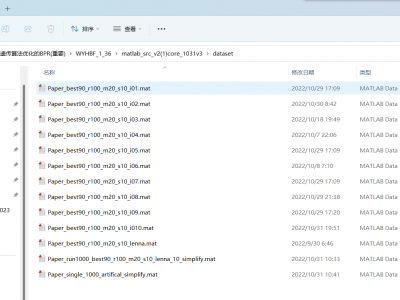Image Processing
In agriculture, the development of early treatment techniques for plant leaf diseases can be significantly enhanced by employing precise and rapid automatic detection methods. Within this realm of research, two common scenarios encountered in real field cases are the identification of different severity stages of diseases and the detection of multiple pathogens simultaneously affecting a single plant leaf. One major challenge faced in this area is the lack of publicly available datasets that contain images captured under these specific conditions.
- Categories:
 205 Views
205 ViewsThis dataset consists of a test result dataset with 10 sample images and a test result dataset with a artificial image. Backpropagation neural networks (BPNNs) can be used to restore images; however, the error surface of the BPNN algorithm contains several extrema, making it easy to slip into a locally optimal solution. A genetic algorithm (GA) with a strong global searchability can optimize the initial weight and threshold of BPNNs. However, traditional GAs are prone to local convergence and stagnation; hence, we propose a hybrid GA.
- Categories:
 273 Views
273 ViewsThis dataset contains 37 estrogen receptor immunohistochemistry (ER-IHC) whole slide images (WSIs) obtained from Universiti Malaya Medical Centre (UMMC), Malaysia. The WSI is scanned using 3DHistech Pannoramic DESK at 20x magnification with an approximate dimension of 80,000 pixels width and 200,000 pixels height per WSI.
- Categories:
 1060 Views
1060 ViewsRealistic benchmark datasets are crucial for providing a consistent measurement baseline for comparing different BlindSR methods and testing their generalization ability in real-world scenarios. However, the evaluation of BlindSR methods is still limited by the lack of a common dataset that conforms to realistic degradation scenarios. We construct a benchmark dataset that follows real scenarios, which reflects the real-world BlindSR problem more accurately than existing synthetic datasets.
- Categories:
 90 Views
90 Views
A novel method is proposed in the paper to obtain the high-precision estimation of the angular velocity and the star-spot’s centroid at the same time. First, the Radon transform on a single frame image is adopted to roughly estimate the initial value of angular velocity and the star-spot’s centroid based on the dynamic imaging and kinematic model. Then, theloss function of each star spot is constructed by combining two consecutive frames.
- Categories:
 36 Views
36 Views
The morphological characteristics of skeletal muscles, such as fascicle orientation, fascicle length, and muscle thickness, contain valuable mechanical information that aids in understanding muscle contractility and excitation due to commands from the central nervous system. Ultrasound (US) imaging, a non-invasive measurement technique, has been employed in clinical research to provide visualized images that capture morphological characteristics. However, accurately and efficiently detecting the fascicle in US images is challenging.
- Categories:
 196 Views
196 Views
This simulation dataset contains five types of data: resolutions, vessels, vessel stenosis, tumors, and shape combinations. There are a total of 1000 original binary images. Besides, we set different gray values on images with multiple connected domains to simulate different concentration of magnetic nanoparticles. Next, the images are subjected to operations such as image inversion and image rotation. The final dataset contains 20,000 images. we applied the X-space method based on the X-space theory and we generated the simulated image of magnetic particle imaging.
- Categories:
 245 Views
245 Views
In industrial microscopic detection, learning-based autofocus methods have empowered operators to acquire high-quality images quickly. Learning-based methods consist of two parts: network model and prior dataset. The network model, which approximates the relationship between input and output, exists fitting error. The prior dataset is made by sharpness metric and used for model training, while the limitations of the metric itself will affect the accuracy of the dataset.
- Categories:
 282 Views
282 Views
- Categories:
 354 Views
354 ViewsIt is a challenging work to solve the geometric attack in the field of digital watermarking. In order to solve the synchronization between the host image and the watermark, image normalization is introduced. Firstly, the geometrically invariant space of image is constructed by using image normalization, and a region of interest (ROI) is obtained from the normalized image by utilizing the invariant centroid theory. Then, the contourlet transform is performed on the ROI. Low-pass sub-band coefficients are divided into non-overlapping blocks.
- Categories:
 122 Views
122 Views



